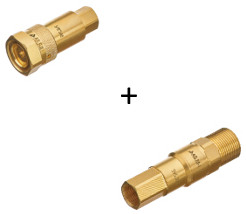Quick Connect?
Many terms and anglicisms for the same object
In common parlance, terms such as “quick connect”, “KlimaLock,” “KlimaLock system,” “KlimaLock adapter,” “KlimaLock systems,” “quick connector,” “connector,” “quick connector,” “quick coupling” or simply “coupling” can be found in connection with refrigerant lines and especially also with split air conditioners.
These terms mainly refer to the same object for connecting refrigerant lines with refrigeration and air conditioning components. These can be, for example, the indoor and outdoor units of split air conditioners or heat pumps.
The correct terminology is “companion valve” or “companion valves.” As defined in the German document of the European Standard EN 378-1:2016 Refrigerating systems and heat pumps – Safety and environmental requirements – Part 1: Basic requirements, definitions, classification and selection criteria, such a companion valve consists of two matching stop valves. These isolate equipment sections and are designed to connect the sections before the isolation valves open. The cocompanion valves are not disconnected until the stop valves have closed altogether.
Companion valve
(Quick-Connect, quick connect, connector, KlimaLock, quick coupling, coupling, quick connector)

Stop valves
(Quick-Connect, quick connect, connector, KlimaLock-adapters, quick coupling, coupling, quick connector)

There is a conceptual difference between the European and German versions. In the original version, the valves matching a companion valve are called stop valves. The author thinks that the “shut-off valve” used in the original version illustrates the function more accurately.
In general usage, these normative terms are simplified and replaced with the Anglicisms mentioned above quick connect, quick connect, Klimalock, KlimaLock system, KlimaLock adapter, KlimaLock systems or also with “quick connector,” “connector,” “quick connection,” “quick coupling” or only with “coupling.”
One Internet retailer even claims that these commonly known companion valves in refrigeration, air conditioning and heat pump technology it is “its patented KlimaLock system.” Thus, the stop valves are advertised as “KlimaLock system” or the stop valves as “KlimaLock adapters,” and systems with these connections as “KlimaLock systems.”
In contrast to the mode of operation of companion valves described in the above standard, consisting of two matching stop valves, terms such as quick connect, quick connect, quick connector, connector, quick coupling, or coupling also include fittings which are only intended for one-time connection before the stop valves open. In this process, membranes usually made of copper are pierced against each other during the screwing process. When uncoupling, the halves do not close again. The refrigeration circuit is, therefore, open and refrigerant can escape unhindered. Simple valves for connecting lines or hoses are also often advertised under these or similar terms.
Companion valves according to EN 371-1 or fittings with the terms quick connect, quick connect, KlimaLock, KlimaLock system, KlimaLock adapter, KlimaLock systems, quick connector, connector, quick connection, quick coupling, or simply coupling, which fulfill the functions described in the standard, serve to protect the environment. Assuming appropriate design and functional reliability, these fittings can safely prevent refrigerant leakage, even when decoupled by non-certified personnel. The connections used, such as flared fittings, are factory-made and thus ensure high tightness and reliability.
The companion valves we have developed are characterized by excellent tightness and high reliability over a wide range of couplings/decouplings. The leakage rates of generations II, III and IV, measured normatively by external institutes, are not achieved by any comparable product known at the time of this printing.
The unique design eliminates the need for torque or other special tools to properly couple the isolation valves. Stop valves without this design are often screwed too tightly due to missing or unsuitable tools. This ensures that the screw connections do not come loose during operation. However, this procedure can place such a load on the thread and the thrust bearing that they fail during operation due to further stresses such as pressure surges or fluctuating temperatures. Even if the functionality of the valves immediately closes the refrigerant lines and sections, the system’s function is interrupted. One or both stop valves have to be replaced with a high installation effort (evacuation of the refrigerant, evacuation of the system, filling of the system).
Of course, the companion valves developed by us, which correspond to the description of DIN EN 378-1, are also offered by our partners under the terms quick-connect, quick-connect, quick-coupling, quick-connector or simply as coupling, to take into account the generally known terms.
